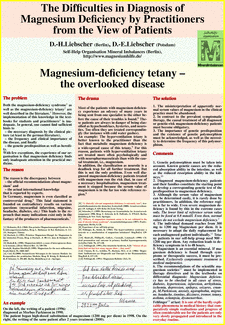- Holtmeier, H.J. (1968):
Das primäre Magnesiummangel-Syndrom.
In: Ernährungswissenschaften,
Hrsg. L. Heilmeyer and H.J. Holtmeier,
S. 111-151. Stuttgart: Thieme.
- Durlach, J. (1992):
Primärer Magnesium-Mangel.
In: Magnesium in der klinischen Praxis,
Hrsg. J. Durlach, S. 80-111. Jena/Stuttgart: Fischer.
- Rude, R.K. (1998):
Magnesium deficit: a cause of heterogeneous disease in humans,
J. Bone Mineral Res. 13, 749-758.
Swain, R. and Kaplan-Machlis, B. (1999):
Magnesium for the next millennium,
South. Med. J. 92, 1040-1047.
Fehlinger, R. (1990):
Therapy with magnesium salts in neurological diseases,
Magnesium Bull. 12, 35-42.
Fauk, D. and Fehlinger, R. (1987):
Transitorische zerebral-ischämische Attacken (TIA) vor dem
50. Lebensjahr - klinische Untersuchungen,
Z. Klin. Med. 42, 2053-2057.
- Csef, H. (2000):
Somatoforme Störungen in der inneren Medizin.
In: Kompendium der praktischen Medizin,
Hrsg. B. König, D. Reinhardt, and H.-P. Schuster. S. 393-402.
Berlin, Heidelberg et al.: Springer.
- Shalev, H., Phillip, M., Galil,
A., Carmi, R., and Landau, D. (1998):
Clinical presentation and outcome in primary familial hypomagnesaemia,
Arch. Dis. Child. 78, 127-130.
- ``A clinically relevant
magnesium deficiency is extremely rar'',
Arzneimittelkommission der deutschen Ärzteschaft (2000):
Arzneiverordnungen (19. Auflage), S. 629. Köln:
Dt. Ärzte-Verlag.
- Schwabe, U. (1999):
Bewertung von Arzneimitteln.
In: Arzneiverordnungsreport 1998,
Hrsg. U. Schwabe and D. Paffrath., S. 579-615.
Berlin, Heidelberg et al.: Springer.
- ``Efficacy of magnesium
treatment seems to be not validated in the case of chronic tetany
syndrom'',
Arzneimitteltelegramm (1997): Positivtelegramm. Berlin, S.126.
- Experience of the self-help
organisation.
- Fehlinger, R. and Seidel, K. (1985):
The hyperventilation syndrome: a neurosis or a manifestation of
magnesium imbalance?
Mag. Bull.4, 129-136.
- Fehlinger, R. (1991):
Zur Familiaritäat des tetanischen Syndroms,
Magnesium Bulletin 13(2), 53-57.
- ``Almost all patients
find out fast how many mg per diem ... they need'',
Fehlinger, R. (1991):
Das tetanische Syndrom, S.24
- Classen, H.G., Achilles, W.,
Bachem, M.G. et al. (1986):
Magnesium: Indikationen zur Diagnostik und Therapie in der Humanmedizin.
Mag. Bull. 8, 127-135.
|


